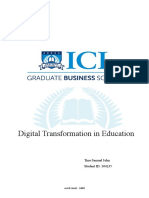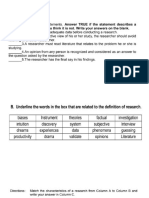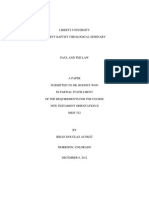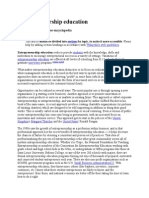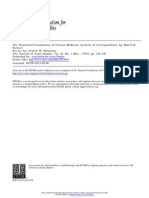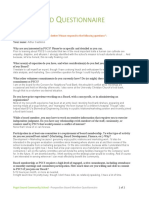Page 1 of 16
MODULE 5 WEEK 5
Topic: Trends in Educational Technology
Subtopic: Projected materials / Audio Materials / Interactive Materials
IV. LESSON PROPER
We live in an era where technology itself often includes practical application of tech solutions in
software development to teaching, learning, and challenges in a creative inquiry. To use the new tech tools
for education in engaging and meaningful ways, it’s necessary to understand the trends driving tech adoption
in the K12 environment.
Some of The Major Trends in Education Technology for The Modern Society
Education is an indispensable part of any modern society, and edTech can unfold a lot of ‘not-
realized’ dreams of education institutes, education, and management. The education field is undergoing
drastic changes because of different factors such as emerging technology innovation, student mobility, and
government regulations. Suppliers in this industry are facing stiff pressure because of the high cost of books,
low-cost interactive web-based courses, and the surge in the use of personal devices.
With easy internet access, the popularity of smartphone use, and social networking, the field of
education has to grab opportunities for content delivery of educational material in the form of eLearning.
Organizations should realize the need for virtual colleges and classrooms. The never-stop tech evolution
necessitates easily accessible as well as reliable web-based education. Companies need to realize their
potential with a new school of thought, best-in-class technology, and the right growth strategy.
Software development companies with years of experience could provide custom software
development for the education industry. Such companies have years of experience working with educational
institutes and publishers and are well-placed to help customers in the field to achieve their objectives and
goals. Customers can achieve benefits such as:
1. Online education 3. Parents’ collaboration 4. Better student assessment
2. Simplified and paperless administration with eLearning information systems.
Six Key Trends in Education Technology
The following are some of the major trends in technology adoption in education:
1. Coding As A Literacy
The future of the digital economy can be driven by those with programming skills and an
understanding of how computers work. It’s becoming more relevant for students to interact with technology,
and so they can control programs, devices, and apps they interact with.
mrdc 2024
� Page 2 of 16
2. Collaborative Learning models prove to be more and more successful. Collaboration mirrors
how humans solve problems, and digital tools help students connect. Synchronous and asynchronous
workspaces are created in tools such as Google Apps for Education and Microsoft Classroom and remove
space, time, and demographic barriers among students.
3. Supporting Students as Creators Learners are starting to explore subjects via active creation
rather than passive consumption of content. Fabrication laboratories, maker spaces, intuitive creative suites
of desktop programs, media centers, and applications provide hands-on opportunities for students to channel
their creativity into solutions, inventions, and expressions.
4. Rethinking How Schools Work Adaptive learning tools, as well as open educational courses,
are personalizing as well as democratizing the way students learn. Combine these with mobile tech such as
a network-connected smartphone or tablet, and students will have a powerful anytime, anyplace, anywhere
learning environment.
5. Redesigning Learning Spaces Flexible learning spaces enable students to create as many
groups as needed for lessons. Network-enabled classrooms enable students to connect and collaborate in
familiar mobile and social modalities, which are part of their day-to-day digital habits outside of the classroom.
6. Deeper Learning Approaches For students to stay motivated, they need to have a sense of how
their skills and knowledge have an impact. Social media platforms such as Twitter, Snapchat, and WeChat
keep students connected to local and global issues. When folded into pedagogy and combined with content
creation tools such as We Video and YouTube, the same outlets can be used to contribute solutions or
insights in meaningful ways.
The Importance of Technology In Today's Education There are numerous reasons why technology is a
major aspect of learning in schools. For students to survive in today's tough competition, they need to
understand technology. These are the reasons why technology is very important in education:
1. Students demand it. Students today are constantly engaging with technology outside the
classroom. Kids like to be interactive, and technology-based learning has now become a part of their
lifestyle.
2. New teachers demand it. Technology has been implemented in post-secondary education and
other professional areas. For new teachers, technology is considered a necessity for learning.
3. Kids can learn at their own pace. Kids want to learn at their own pace, but at times traditional
classrooms make it hard to do so. With technological integration in education, children can slow
down and go back over concepts and lessons, and more advanced kids can go ahead. Also,
technology allows teachers to help children on a more one-on-one level.
4. Kids are digital natives. Children know technology better than most adults. It’s become the easiest
way they learn since it is an integral part of their life. Technology engagement in the classroom helps
children not only learn better but also acquire multi-tasking skills.
mrdc 2024
� Page 3 of 16
5. There are no limitations with technology. Having access to other information outside of school
material provides students with various ways of learning a concept. Teachers can come up with
creative ways of teaching their students, which keep them engaged. Technology has changed the
learning space, so learning is now more hands-on.
Technology can help teachers do a better job, not replace them. Thus, teachers don't have to worry
about the way technology is revolutionizing the field of education. As schools and teachers continue adopting
a growing number of tech solutions and software development tools, it’s important to consider new trends in
education and how students learn. Like other sectors in today's society, the field of education should be
updated with the latest technologies to meet students’ needs.
How Can Teachers Benefit from Augmented Reality in Education?
Augmented Reality in education can transform the way teachers deliver lectures. The technology will
not only help teachers in making lessons more interactive, but it will also benefit students by making it easier
for them to understand tough subject matters and topics.
5 Ways Teachers Can Use AR In Education
1. Making Classes More Interactive
The whole point of using technology in classrooms is to make learning more interactive and
engaging. This is what Augmented Reality technology does. It helps teachers get the attention of students in
no time and it increases engagement levels as well. It brings to life abstract topics, such as set theory and
logical reasoning, and makes learning more effective than ever. Let students scan images from their
textbooks and learn with 3D models. You can make classes even more interactive with the help of 3D
simulations that let you perform physical experiments in a virtual world. This way students can learn through
experiential learning by trying several iterations to find out the most suitable combinations.
2. Being A Guide
Unlike other technologies, Augmented Reality lets teachers and trainers act as a guide in the
classroom. It is not just a video solution that minimizes the involvement of teachers in the classroom, rather
it lets you guide the whole session. Take charge of the classroom by mentoring the session, and don't just
give orders and instructions. Make students familiar with the technology. You can also begin by making them
aware of the benefits of Augmented Reality in education and how they can use the same for better outcomes.
Be someone who they can count on for support and not someone they fear conversing with.
3. Teaming Up with Students
When teachers become mentors, classes become fun and interactive. Modern students are more
engaged in learning when technology is used in some form or the other. Augmented Reality in education has
been proven to improve teacher-student collaboration in classrooms. This is because it makes use of game-
based digital elements that have the power to intrigue students.
Explore the marvels of the world together with your class and help them use technology. Teachers
mrdc 2024
� Page 4 of 16
can begin with simpler topics and gradually focus on more complex ones. You can also ask which topics your
students find the most challenging and plan lectures accordingly. Also, doubt-clearing sessions will no longer
be ordinary when Augmented Reality technology is put to use.
4. Making the Most of Technology
The education sector has always been the last domain to adopt newer technologies. Now is the time
for teachers to make the most of Augmented Reality in education and deliver lessons in a better way. Being
rigid and not becoming familiar with novel evolutions and advancements is not the solution. Rather, teachers
and educators should learn how to operate and use gizmos and gadgets to satisfy the likes of modern
students.
Use the power of the new-fangled technology to leave students awestruck. It takes a few seconds to
scan 2D images in a textbook and convert them into 3D interactive models. Use this feature to grab the
attention of learners. Keep them engaged with the help of simulations and let them practice until they become
fully versed. The idea is to make the most of technology.
5. Using Technology for Evaluation
Evaluation can be fun. Why do examinations have to be dreadful? Why can’t tests be designed so
that students find it fun to participate? Well, Augmented Reality in education can do that as well! Most learning
management software and apps that come equipped with Augmented Reality technology have the feature of
fun quizzes and tests. Instead of taking a test in a notebook or on paper, students can make use of these
applications to lock in their answers.
Another interesting way to make the process of assessment exciting is by using puzzles and quizzes.
While this might not work for every topic, it can do wonders for subjects like history, and biology, or for learning
mathematical formulas. The idea is to make learning a fun affair and not something students perceive as a
burden.
Some of the trends that are particularly noticeable in educational institutions throughout the world
include the use of technology in the classroom which includes but is not limited to gamification and the use
of educational apps, inquiry-based education, focus on performing arts as a supplement to a regular
academic
Better research allows the science of teaching to keep improving as we better understand
how learning takes place and what can best be done to encourage students. Legislation
regarding education enables lawmakers to address the changing needs of students and society as they
change over time.
Trends in Educational Technology
What are the biggest educational technology trends we’ll see heading into the next decade? We’re
here to give you the inside scoop so you know what to pay attention to in 2020 and beyond. From artificial
intelligence to video-based learning to wellness tech, the emerging edtech trends have a lot in store for
teachers and students alike.
mrdc 2024
� Page 5 of 16
The online learning space is evolving rapidly, and edtech is a big part of that. In Australia, we’re now
seeing everything from web-based school management platforms like Compass, tutoring platforms like
Cluey, open marketplaces for MOOCs like Open Learning, ICT infrastructure solutions for schools like Critical
Links, 3D printing training providers like YSoft’s be3D Academy, and mobile apps like Teach.com.au. These
products and services make life easier for teachers and students, promoting engagement, collaboration,
communication, and efficiency.
According to a recent survey by Houghton Mifflin Harcourt, 83 percent of teachers are optimistic
about the potential of technology to expand teacher capacity. At the same time, half of those surveyed
reported a lack of time to implement that technology into their instruction, as well as inadequate student
access to devices outside the classroom. But we’re starting to see ed tech that is designed to tackle these
concerns, from easy-to-adopt classroom management platforms to educational apps students can access
anytime, anywhere.
“While this may not seem like relevant information for teachers and students, it means educational
technology will become better, more accessible, and more affordable for your classroom shortly. Hold tight
for a wild ride into the ‘20s.
Top EdTech Trends for 2020
Student and teacher wellness
Teacher burnout and student anxiety aren’t new phenomena but removing the stigma around them—
and seeking tech-based solutions—is relatively new. Mind Moose is a mobile app designed to teach primary
students about mental health. Short animations introduce topics like brain science, self-awareness and self-
esteem, managing emotions, solving problems, and developing resilience. Students earn certificates and
badges as they progress.
AI
Increasingly be used to personalize learning in 2020. For instance, Querium in Austin, TX is using
AI to deliver customizable STEM tutoring lessons to high school and uni students. The software works by
analyzing answers and length of time it took to complete the tutoring sessions, thereby giving teachers
insights into areas of weakness for students. New challenges are introduced to students based on their
strengths and weaknesses, and predictions are made about future performance based on current learning
patterns.
Video-based learning
Is becoming increasingly popular with younger generations. YouTube is the preferred educational
medium of Generation Z. Teachers can use not only Youtube but Teachertube and BrainPo to use or create
instructional videos on various subjects, either to supplement or present new material. Video-based learning
can be especially useful for background information or material that normally would take a lot of time to learn
by reading a textbook. If student motivation is lagging for an assignment, default to video if you can.
Data privacy
mrdc 2024
� Page 6 of 16
FERPA, COPPA, and SHERPA have established data privacy standards that edtech companies
must follow to keep student data safe, but what does this mean for teachers? Faud Khan, CEO of Twelvedot,
wants to remind educators that “compliance does not equal security.” EdTech companies must take
responsibility and ensure that student data is used according to law: “EdTech companies must build a culture
of security because ‘schools and government will never be agile enough or have the resources to stay on top
of it. It is the responsibility of the EdTech companies to ensure data security and they must take this
responsibility seriously.’”
Collaborative technology
Tools support online learning through chatbots; platforms and apps that promote peer-to-peer
engagement; and groups, blogs, and wikis. Students can use chat tools they already know like Facebook,
WhatsApp, or Skype—or they can use chatbots like Google Allo for a more personalized online learning
experience, as a source of social learning, to save teachers time, and for online assessments.
To collaborate during lessons, students are using Google Apps for Education, Recap, Talkboard,
GoSoapBox, and Padlet. Groups can be created in Learning Management Systems to boost engagement
between students, to help teachers’ moderate online discussions, and to give and receive feedback.
Mixed reality
Will be used to enhance the online learning experience more and more. Expect demand for these
virtual yet social environments, which allow students to raise their hands, organically ask questions, and feel
more invested in their studies.
A recent study by Stanford researchers found that VR field trips about climate change resulted in
“participants who explored more of the virtual space formed deeper cognitive associations with the science
content and could learn, recall and retain the causes and effects of ocean acidification better than those who
did not explore the underwater world as much.”
Blended learning
A mix of on-campus and off-campus learning will become more popular in the next decade as people
try to balance digital connection with human connection. Digital technologies for online learning will become
more advanced, leading to higher quality online learning sessions, which means, ironically, more time can
be spent face-to-face again. Teachers become more facilitators than instructors in a blended learning
environment, which means students can empower themselves to learn and continue learning even after their
formal studies are over.
Machine learning
Before long, predictive analysis will be able to tell us about a student’s academic future. Teachers
will be able to target students who may be at risk for dropping out of a course, which may be especially useful
for online course providers. Improving student results and customizing programs are promising facets of
machine learning as well. For instance, Netex Learning is a machine-learning-enabled web platform that lets
tutors design a curriculum for the day. Teachers can create plans around content which includes videos,
mrdc 2024
� Page 7 of 16
audio, personalized assignments, and discussion portals.
Learning platforms
Online learning platforms like Open Colleges’ Open Space are designed to make learning more
convenient for students. With a tool like Open Space, you can access all your course materials, submit
assignments, receive feedback, and check your grades all in one place. It’s convenient and easy to use, and
comes with a support network of educators and peers to help egg you on when you need a motivation boost.
Fortunately for teachers and students, this means better education delivered more efficiently, when and
where you like. Staying abreast of the latest trends going into the next decade isn’t such a burden when more
and more of that technology is designed to keep you informed in a way that respects your time and energy.
In the next decade, educational technology will not only make learning easier but will be easier to learn. Stay
tuned.
10 *Good* reasons to use technology in classrooms
Many new technologies are being used in classrooms today: social networking, online teaching,
class blogs and wikis, podcasting, interactive whiteboards, and mobile devices.
This has probably been the case for the last 15 years at least when we moved away from the
traditional ICT Suites and began implementing interactive technologies in most classrooms. So other than
just continuing with the tech trend, we're stepping back to explore some valid reasons for having these
technologies.
1. Students love technology
They expect it too. As long as they have the tools they love, they are more likely to engage
with the lesson content and their personal learning journeys.
2. Prepare students for the future
It's unlikely that your students of today will enter the world of work without needing to use a
device of some kind. Whilst it won't be expected that they can pick up and use all devices to their full
functionality, it would be extremely beneficial if they were well equipped to use a range of devices.
3. Improve collaboration
This is a hot topic everywhere at the moment...and for good reason. Collaboration is, without
a doubt, key to unlocking great work. In the words of Mother Teresa "I can do things you cannot, you
can do things I cannot; together we can do great things." Technology of today is all about boosting
collaboration...so students can achieve more.
4. Active learning
Learning is not just a case of listening, repeating, or remaining passive. It's time to let the
teacher step away from the front of class, and immerse themselves where the learning is taking
place.
5. Technology is safe
mrdc 2024
� Page 8 of 16
When taught how to use it in conjunction with open discussions regarding online safety and
classroom monitoring, there's no reason to be afraid of it. Instead of it just being used as an incentive
or treat, it's never been safer to use technology as part of facilitating learning.
6. Becoming digital citizens
It's our responsibility to make sure the learners of today have the awareness of what it is to
be a responsible digital citizen. Using devices within a safe learning environment provides nurture
and advice and develops a clear understanding of safe online use.
7. Teaching different learner types
The concept of different learner types is widely disputed in education...but why not cover all
bases anyway? With sensibly used technology, it can bring about diversity in the way content is
consumed and absorbed, helping reach a larger number of students.
8. Information is NEW
Digital information is the way to get the most up-to-date and relevant information. Whether
this is because content is frequently created, or simply because it's quicker to source it. What's more,
learners are more able to become world citizens when they're encouraged to investigate what's going
on using a device they love.
9. Responsibility
Learning at your own pace whilst meeting guidelines and deadlines becomes easier to
achieve. Learning is in the hands of the student, so they can become more responsible and take
ownership of their learning journey and the resources they access. These are all key transferable
skills when it comes to life.
10. Varied end results
With a greater wealth of content, presentation options and endless resources, you're bound
to end up with much more variety and creativity in the work that is produced. Not only is this more
interesting for a teacher, it also serves as a significant learning experience for your students. They'll
develop their ideas from each other...enhancing their knowledge and understanding of topics. You
don't always need the latest and greatest kit, but technology needs to work for your school and your
students for them to make the most out of their education.
Projected Materials/ Aids
Over time, technology has changed to allow people to communicate efficiently and has gone from a
means to making difficult tasks easier. Technology has always been a present force in the world. It started
as simple tools created by the most primitive humans and evolved into other tools that made life easier for
the people and the inventor himself. In the mid-20th century, technological advances began to boom.
Engineers and educators began to look for new ways to make computers do tasks as media that would help
them during class. Projected and electronic materials are forms of media that could be visual, audio, and
audio-visual in nature that requires projection and electricity in their use process for teaching and learning
situation.
mrdc 2024
� Page 9 of 16
Overhead Projection
The first projected visual aid that comes into the world is OHP. The typical overhead projector is a
simple device that consists of a box with a large aperture or “stage” on the top surface. This device makes
use of transparency which later is called acetate (individual sheets of transparent film) and overlays (sheets
of transparent film).
Slides
The slide is a more modern one than OHP. It refers to a small-format photographic transparency
individually mounted for one-at-time projection. Slides may be used at all grade levels and for instruction in
all curriculum areas.
Sound-Slides Sets
In manual operation, the visual and audio components are usually separated. The presenter needs
to ensure that the visual and audio are synchronized. In automatic operation, it uses two soundtracks – one
for audible narration and one for inaudible tones that activate the advanced mechanism on the slide projector.
Multi Image Presentation
Multi Image is the earlier form of video player. It is any visual presentation showing several images
simultaneously, often using multiple screens. In education, it is usually produced for persuasive purposes
like enlisting parent support for new programs, heightening students’ awareness of issues, to arousing
interest in new classroom techniques.
Filmstrip
A filmstrip is a roll of 35mm transparent film containing a series of related still pictures intended for
showing one at a time.Narrative information is printed at the bottom of each frame or is recorded separately.
As slides can be made by the teacher and students, filmstrips are better suited to mass production and
distribution.
mrdc 2024
� Page 10 of 16
Opaque
Projection is a method of enlarging and projecting nontransparent material on screen. It works by
directing a very strong incandescent light down onto the material. This projector is useful for many small
groups or classroom-size groups that need to view printed or visual material together.
Computer Image Projection
Liquid crystal display (LCD) projection panels project computer images onto the screen. This works
as the same as reflective OHP, minus the transparency. An LCD panel is plugged into the computer and
placed onto the stage of a high-intensity overhead projector. The projector light shines through the LCD
panel, projecting the image on a screen.
Audiovisual materials,
Such as videotapes, DVDs, audio tapes, audio CDs, and microforms, can be difficult to identify and
access. Unlike books and journals, which are covered by regular bibliographic tools, audiovisual materials
are not systematically covered. Audiovisual materials are particularly important in educational environments,
with university and school libraries generally holding strong audiovisual collections. Increasingly, audiovisual
materials are available through the open web, although much material has been placed on the open web
without the copyright owners’ permission, and users have to be cautious about downloading and using the
material, and particularly about passing audiovisual materials on to third parties, such as students in a class.
Interactive Learning Materials (ILMs)
are learning modules that are being developed to
stimulate and engage student's learning. In
addition, it can support specific
interactions between the software and the user,
which can help save time and effort both for the
students and the teacher. Interactive teaching
materials are a combination of two or more media
(audio, text, graphics, images, and video) that are
manipulated by the user to control the order and or
the natural behavior of a presentation. A. Definition
of Interactive Teaching Material.
B. The Importance of Interactive Teaching Materials
for Learners
mrdc 2024

































